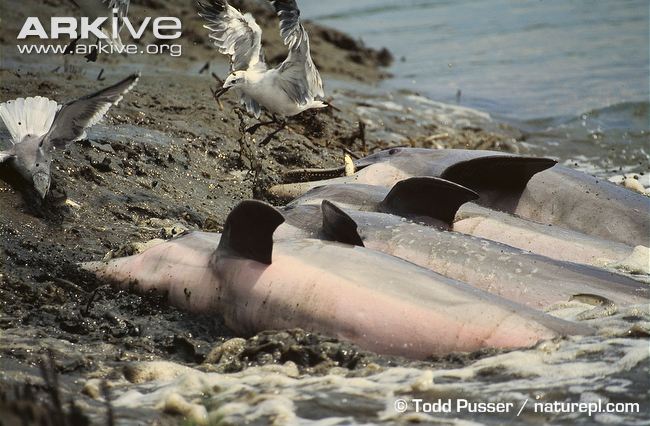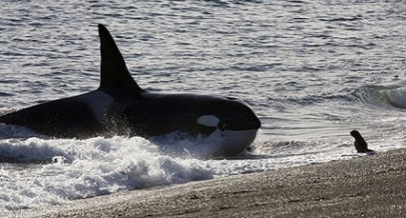Beach Hunting as a Foraging Strategy in Orcas and Dolphins
If you are an avid whale watcher, I’m sure you’ve seen whales or dolphins feeding a couple times, or at least have some idea of what it’s like: you’ll see one or more animals splashing around near the surface and you may even see a fish or two fly up in all the chaos. However, I’d be willing to bet a lot of money that you haven’t seen a whale or dolphin swim up onto land to catch a fish. What? Swim onto land?! Impossible as it may seem, this is actually a documented hunting method in more than one species of dolphin and in orcas: it’s called beach hunting, or sometimes strand feeding.
Odontocetes, or toothed whales like dolphins and orcas, can behave differently depending on where they are and which other animals they are with. Foraging behaviours, or those behaviours used for finding and eating food, can vary greatly between populations and can even vary within certain populations (Sargeant, 2005; Silber & Fertl, 1995). Bottlenose dolphins alone have dozens of different techniques for finding their prey, including following fishing boats to get discarded fish, using their nose to dig into the ocean bottom, smacking their tails over shallow water to disturb and frazzle their prey, using marine sponges worn over their noses to aid in finding food, and perhaps most impressively, intentionally stranding themselves on beaches or mud flats to catch a single fish (Sergeant, 2005). This behaviour known as “beach hunting” (or strand feeding in some cases) has been observed for decades in multiple species and populations of dolphins and orcas. By definition, beach hunting involves dolphins and whales hauling themselves out of the water onto land in order to hunt and catch usually a single fish, although small schools of fish are sometimes chased onto shore (Santos, 2010). It may seem like a death wish for these animals, but surprisingly, this behaviour has evolved separately in multiple populations around the world, and is even taught to the younger generations.
All published observations of beach hunting in orcas have been made mainly in the Crozet Archipelago in Patagonia (Guinet, 1990; Guinet & Bouvier, 1995; Lopez & Lopez, 1985). In 1985, Lopez and Lopez published some of the first observations of orcas “intentionally stranding while hunting” in southern Argentina. This paper described the method of beach hunting in detail: a whale about to beach itself would swim towards the shore in the direction of the prey, sometimes using a wave for extra speed. The whale would catch the prey item usually in the surf zone on the beach in areas where the prey was still capable of swimming. To go back into the water, the whale would turn its body so it was parallel to the shore and wait for a large wave to carry it back to sea. Shockingly, none of the whales observed in this account remained stranded on land. Here is a video to show you what exactly beach hunting looks like in orcas. National Geographic Film: Killer Whales Attack on Shore
While orcas have only been seen beach hunting in one region, multiple species of dolphin have been observed practicing this behaviour in locations around the world. Beach hunting has been seen in humpback dolphins in the Indian Ocean, common bottlenose dolphins in the United States, Australia, and Mexico, and Guiana dolphins on the coast of Brazil (Santos, 2010; Sargeant et al., 2005; Silber & Fertl, 1995). In 1995, Silber and Fertl published observations of beach hunting in wild bottlenose dolphins in the Colorado River Delta, Mexico. Dolphins were seen swimming onto soft mud or banks with gradual slopes, making the return to the water easier. These dolphins beached on their sides, not their bellies, and always turned clockwise to return to the water. Similar behaviours were observed in Brazil and Australia. Guiana dolphins in Brazil sometimes even teamed up, only temporarily, to beach hunt. Here’s a video of dolphins beach hunting. ABC News Film: Rare dolphin beach feeding frenzy caught on video in central Queensland river estuary
Throughout all the research and observations of beach hunting, it became clear that this behaviour was being taught to the young whales and dolphins. Both orcas and dolphins have been observed beach hunting together with older adults who would capture prey and throw it to the juveniles, or assist the juvenile in their own capture. In terms of orcas, both Guinet (1990) and Guinet & Bouvier (1995) observed that adult males rarely participated in beach hunting, and that it was usually the females who assisted in the juveniles’ learning of the behaviour. This hunting strategy clearly has some danger associated with it because an inexperienced and young whale could easily find itself stranded. Only at six years old are calves able to catch their first elephant seal pup, but at this point they still may need the assistance of an adult female. This is different from other foraging strategies that usually develop within the first few years of life. Due to the high degree of “technical difficulty” this behaviour presents, apprenticeship between juveniles and adults can enhance and ensure the survival of the calves by lowering the risks, and plays an important role in the handing down of this hunting technique from one generation to the next.
Beach hunting was also found to develop later than all other foraging strategies in young dolphins. In bottlenose dolphins, calves are able to perform most foraging strategies within their first year of life while full beach hunting was not observed for until at least age six. Like the orcas, the difficulty and potential risk of intentional stranding requires a longer period of learning and more assistance from adults (Sargeant et al., 2005). As with the orcas, beach hunting in dolphin species appears to be mostly female-dominated. In Guiana dolphins and bottlenose dolphins, the vast majority of beach-hunting adults are female, and this behaviour is more likely to be passed on to daughters rather than sons. (Santos, 2010; Sargeant et al., 2005).
No one knows exactly why dolphins and orcas beach themselves on purpose, if for no other reason than to surprise human observers and unprepared seals. Most scientists agree that beach hunting probably developed as a way for these animals to take advantage of all available food. For orcas, this allows them to hunt mostly land-based prey like as seals and penguins. Beach hunting in bottle-nosed dolphins is thought to have developed as an extension of hunting schools of fish in shallow water against mud and sand banks (Santos, 2010; Silber & Fertl, 1995). Overall, even if we don’t know exactly why it happens, beach hunting is just another example of how incredible and dynamic marine mammals, especially dolphins and orcas, can be!
Written By Emma Weitzner – 1st June 2015
References
Guinet, C. (1991). Intentional stranding apprenticeship and social play in killer whales (Orcinus orca). Canadian Journal of Zoology, 69(11), 2712-2716.
Guinet, C., & Bouvier, J. (1995). Development of intentional stranding hunting techniques in killer whale (Orcinus orca) calves at Crozet Archipelago.Canadian Journal of Zoology, 73(1), 27-33.
Lopez, J. C., & Lopez, D. (1985). Killer whales (Orcinus orca) of Patagonia, and their behaviour of intentional stranding while hunting nearshore. Journal of Mammalogy, 66(1), 181-183.
Santos, M. C. D. O. (2010). Guiana dolphins (Sotalia guianensis) displaying beach hunting behavior in the Cananéia estuary, Brazil: social context and conservation issues. Brazilian Journal of oceanography, 58(2), 143-152.
Sargeant, B. L., Mann, J., Berggren, P., & Krützen, M. (2005). Specialization and development of beach hunting, a rare foraging behaviour, by wild bottlenose dolphins (Tursiops sp.). Canadian Journal of Zoology, 83(11), 1400-1410.
Silber, G. K., & Fertl, D. (1995). Intentional beaching by bottlenose dolphins (Tursiops truncatus) in the Colorado River Delta, Mexico. Aquatic Mammals, 21, 183-186.


























